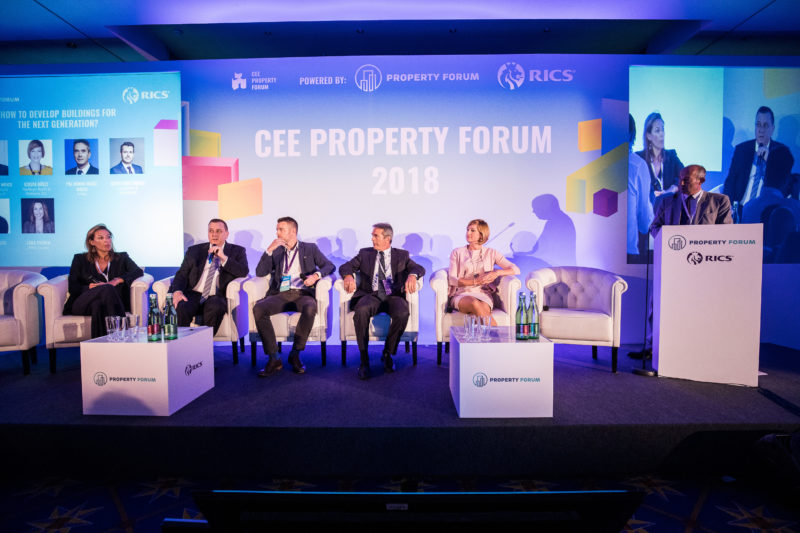One of the main topics of this year's CEE Property Forum was the question concerning the future of real estate industry and the effects of new technologies and new needs of users on the industry. What kind of needs do the buildings of today and in the next 20-30 years have to fulfill? What kind of architectural solutions and planning methods facilitate these? In the plenary discussion of the second section of the conference the participating experts discussed the questions about building development for future generations, where the company group was represented by the Business Development Director of Paulinyi-Reith & Partners, Szilvia Bősze.
Our lifestyle and working patterns are changing due to the new technologies. We are just researching the need of the upcoming generations. In order to be able to adapt to these changes, we need spaces that allow us to do so. During the discussion it was revealed that the need for flexible, activity-based multifunctional spaces become bigger among tenants - and consequently among investors - because of the fast changes regarding working patterns, expectations and trends.
Experts have agreed, that upcoming generations have a higher level of environmental awareness than the people who are currently in decision-making positions. As an example the expert of IFMA mentioned certain cases, where potential employees refused to accept a given position due to the formation of the office, or the negative judgment on the future employer’s environmental protection habits. Therefore the competition is on, and it is very complex.
When we are designing for the future generations we can no longer look at certain projects on a building-level but at a much larger, city-wide scale. Even considering solely the traffic aspect, right now there are legal regulations limiting the minimum number of parking spaces attached to certain buildings/services. But what will happen to these fix infrastructures in the age of electric or even further self-driving cars?
The responsibility of key characters affecting the changes in office availability was also discussed, and experts have agreed with the designing and operating point of view, stating that we are only able to fulfill the demands of next generations if there are multiple characters involved in the decision making process. At Paulinyi-Reith & Partners owing to the Integrated Design Process we create a knowledge-platform where all the participants of the building project contribute with their expertises. Besides the architects and engineers experts of social sciences and economy, the developer, the implementer and the operator also represent themselves during the design process (http://p-rp.hu/en/munkamodszerunk).
Szilvia Bősze also proved through a couple of examples how architects concerned about future generations and the planet can do for sustainability and forward thinking architecture. As an example, Paulinyi-Reith & Partners is constantly striving for widening the design methods and knowledges: ABUD (Advanced Building and Urban Design) - the sustainability strategy partner and provider of the company group - is participating in numerous international researches, the company group uses the knowledge gained on these in practice. For example user behavior examination of completed Paulinyi-Reith & Partners projects compared to international benchmarks; the research made for the European Union, which ended in the COMBI (Calculating and Operationalising the Multiple Benefits of Energy Efficiency in Europe) project this year that quantifies the effects of energy efficiency provisions (http://www.abud.hu/portfolio/research/combi); and the international study made for Global Buildings Performance Network (GBPN) in 2012 that examined the effects of investment costs and energy savings (http://www.abud.hu/portfolio/research/research-study). Various researches showed that the energy efficiency solutions which are often more expensive during the development, returns their cost multiple times during the operation of the building.
The interesting panel discussion led by Silvio Estienne MRICS (RICS Europe) the participants approached the question from the percpective of the designer (Szilvia Bősze, Paulinyi-Reith & Partners) the market analyser (Pál Dános MAISz, MRICS, KPNG) the real estate consultant (Glyn Evans MRICS, Cushman & Wakefield, John J. Fekete MRICS, JLL) and the operator (Lara Paemen, IFMA Europe); but they all agreed that the role of the needs of users becomes more important. According to Szilvia Bősze it is particularly true for the CEE region, where the acquisition and retention of workforce is expected to challenge the employers and therefore the developers and designers, because of the migration tendency.
Gergő Burián, Director of Design at Paulinyi-Reith & Partners also attended the event. According to his opinion based on regional CEE trends a remarkable economic growth is still present in the real estate sector. Nonetheless during the execution process we have to create and use new solutions to decrease the amount of on-site living labour, like prefabrication or automatization. Besides this the distinctness of various projects among the competition is also a very important aspect, considering quality, provided services and structure.
